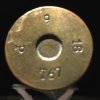Anyone got a round?
https://www.facebook.com/ww1incolour/photos/a.603654039778452/2285213668289139
New Zealand Cavalry soldiers pose with a captured German Tankgewehr M1918 – The World's First Tank Killer Rifle
What the Germans needed as much as tanks was something to stop the British and French tanks and this was the Mauser 13.2mm Tank Abwehr Gewehr Model 18 or "Mauser 1918 T-Gewehr." Known simply as the Tankgewehr, it was an upscaled bolt-action rifle that was based on the Mauser action. Unlike the Gewehr 98 – the standard service rifle used from 1898 to 1935, which featured an internal five round magazine – the T-Gewehr was a single-shot weapon that had to be manually loaded each tip. It also differed from other rifles of the era in that it had a pistol grip and bipod.
What the Tankgewehr lacked was anything to reduce the recoil, including a muzzle brake or even padded buttpad. Shooting multiple rounds could take a toll on the man charged with firing it. The rifle was developed after the British had launched the first full-scale tank offensive at Cambrai in the fall of November 1917, and pushed the Germans back some 20 kilometers.
The massive rifle was chambered to fire a powerful 13.2 TuF (Tank und Flieger-Tank and Aircraft), a .525-cablier jacketed, armor-piercing, steel-core cartridge. Effective range was about 500 meters, but gunners had to fire over iron sights.

https://www.facebook.com/ww1incolour/photos/a.603654039778452/2285213668289139
New Zealand Cavalry soldiers pose with a captured German Tankgewehr M1918 – The World's First Tank Killer Rifle
What the Germans needed as much as tanks was something to stop the British and French tanks and this was the Mauser 13.2mm Tank Abwehr Gewehr Model 18 or "Mauser 1918 T-Gewehr." Known simply as the Tankgewehr, it was an upscaled bolt-action rifle that was based on the Mauser action. Unlike the Gewehr 98 – the standard service rifle used from 1898 to 1935, which featured an internal five round magazine – the T-Gewehr was a single-shot weapon that had to be manually loaded each tip. It also differed from other rifles of the era in that it had a pistol grip and bipod.
What the Tankgewehr lacked was anything to reduce the recoil, including a muzzle brake or even padded buttpad. Shooting multiple rounds could take a toll on the man charged with firing it. The rifle was developed after the British had launched the first full-scale tank offensive at Cambrai in the fall of November 1917, and pushed the Germans back some 20 kilometers.
The massive rifle was chambered to fire a powerful 13.2 TuF (Tank und Flieger-Tank and Aircraft), a .525-cablier jacketed, armor-piercing, steel-core cartridge. Effective range was about 500 meters, but gunners had to fire over iron sights.



